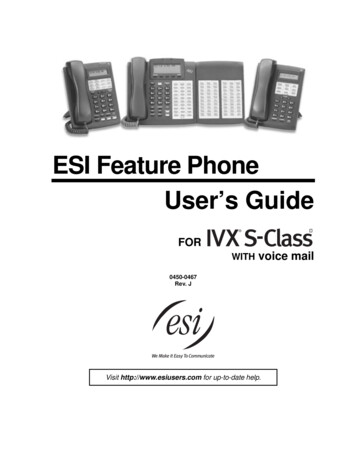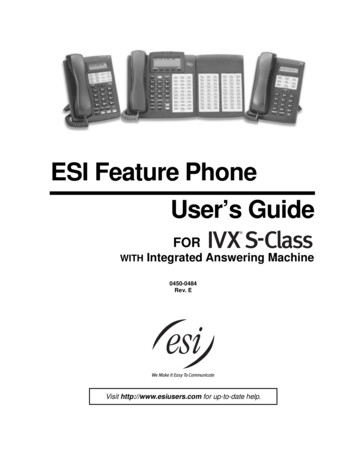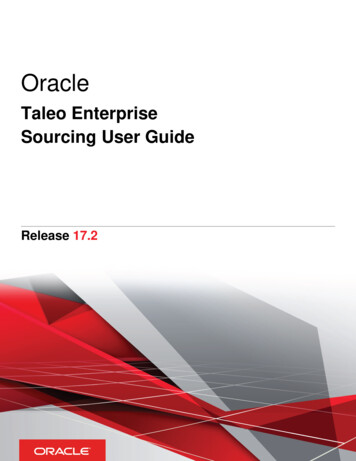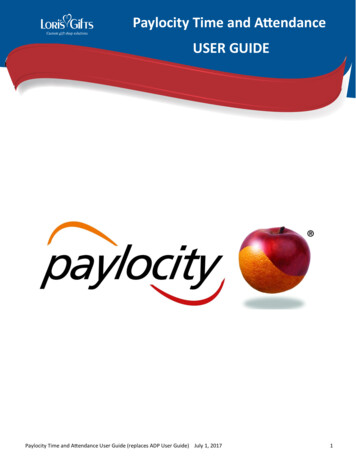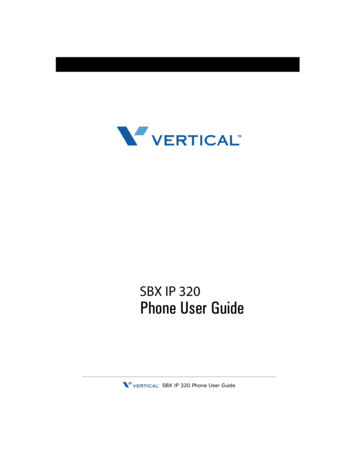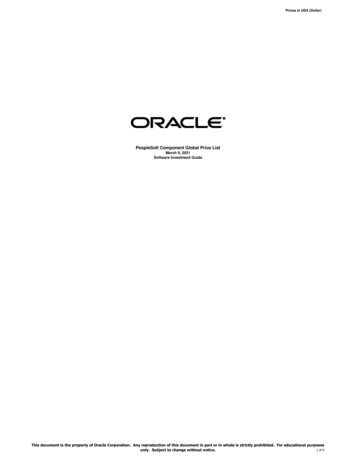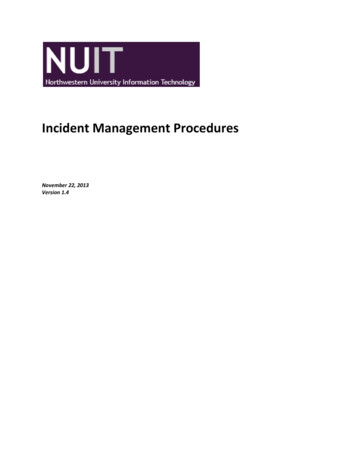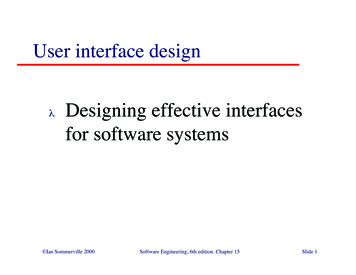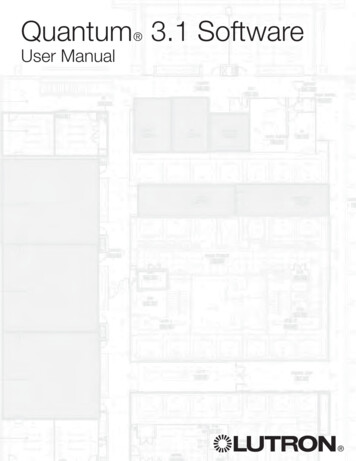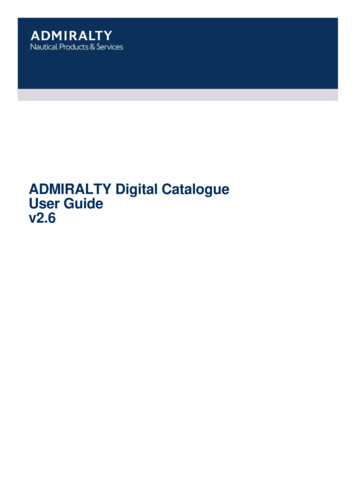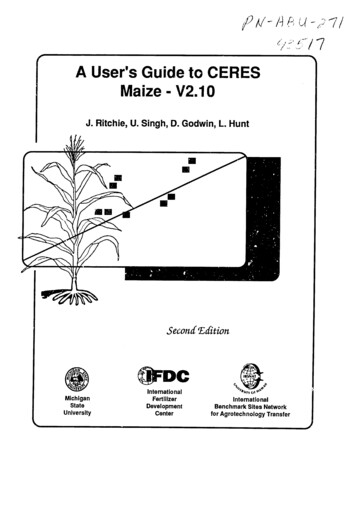
Transcription
A User's Guide to CERESMaize - V2.10J. Ritchie, U. Singh, D. Godwin, L. HuntSecond mark Sites Networkfor Agrotechnology Transfer
International Fertilizer Development CenterP.O. Box 2040Muscle Shoals, Alabama 35662, U.S.A.The authors disclaim all warranties, whether expressed or im plied, as to CERES MAIZE model fitness, performance, or simulationaccuracy for any purpose and assume no liability or responsibility tothe purchaser or anyone for loss or damage caused by the use ofCERES MAIZE. This disclaimer of liability includes, but Is not lim ited to, the loss of data, time, and/or monetary losses. The authorsare not liable for direct, indirect, and/or incidental damages result ing from defects, errors, or failure to perform by CERES MAIZE.CERES MAIZE V2. 1-11
Table of ContentsCHAPTER 1CHAPTER 2CHAPTER 3CHAPTER 4CHAPTER 5CHAPTER 6CHAPTER 7CHAPTJR 8CHAPTER 9CHAPTER 10CHAPTER 11CHAPTER 12REFERENCESAPPENDIXModel Overview . 1System Components . 3System Requirements . 4Getting Started . 5Running CERES MAIZE on a Two-Diskette System . 6Running CERES MAIZE on a Hard-Disk System . 8System Setup for CERES MAIZE Graphics . 9Problem s .10Procedures to Add New Experiments for Simulation . 12Single-Year . 12Manual Creation of Files . 12Data Entry with INPUTS Program . 15Multiple-Year . 16Example Simulation . 17Single-Year Simulation . 18Multiple-Year Simulation . 36Simulation Output Frequency . 41Sensitivity Analysis . 43Screen Exam ples . 45Genetic Coefficients . 60.64.89List of .19.20.21.22.Files in "I. CERES MAIZE V2. 10 PROGRAM" diskette.Files in Subdirectory Source of "1. CERES MAIZE V2. 10PROGRAM" diskette.Files in "2. CERES MAIZE V2. 10 DATA" diskette.Files in "3. CERES MAIZE V2. 10 INPUTS" diskette.Files in "4. CERES MAIZE V2. 10 GRAPHICS" diskette.File "MZEXP.DIR"File "IBWA101O.W83" (for the first 30 days only).File "WTH.DIR"File "SPROFILE.MZ2"File "IBWA8301.MZ8"File "IBWA8301 .MZ6"File "IBWA8301.MZ5"File "IBWA8301.MZ7"File "IBWA8301.MZ4"File "GENETICS.MZ9"File "IBWA8301.MZA"File "IBWA831.MZB"File "GLABEL.DAT"File "GLABEL2.DAT"File "GLABEL3.DAT"Fle "IBS18001.MZS"Sample Genetic Coefficients for Maize Genotypes Adapted toDifferent Environmentsiii--CERES MAIZE V2.1
CHAPTER IModel OverviewCERES MAIZE V2. 10 is a process-oriented, management-levelmodel of maize (Zea mays L.) crop growth and development that alsosimulates soil water balance and nitrogen balance associated withthe growth of maize. It is a daily-incrementing, user-friendly, menu driven model written and compiled in Microsoft FORTRAN V4.01 andQuick BASIC V4.0. It may be run on an IBM or IBM-compatiblemicrocomputer with either a floppy-disk or a hard-disk system. Ithas been developed by ani international and interdisciplinary team ofscientists over a period of several years. Dr. Joe Ritchie of MichiganState University, and formerly of the United States Department ofAgriculture-Agricultural Research Service (USDA-ARS), Temple,Texas, has coordinated development of the model. The nitrogen sub model was primarily developed by modelers at the InternationalFertilizer Development Center (IFDC), Muscle Shoals, Alabama withcollaboration from Dr. C. A. Jones of USDA-ARS, Temple, Texas. Anearlier version of the model has been documented (Jones and Kiniry,1986) and widely tested, Including extensive testing in the tropics(Singh, 1985).The model uses a minimum of readily available weather, soil. andvariety-specific genetic inputs. To simulate maize growth, develop ment, and yield the model takes into account the followingprocesses:" Phenological development, especially as it is affected by genotypeand weather;" Extension growth of leaves, stems, and roots:* Biomass accumulation and partitioning, especially as phenologicaldevelopment affects the development and growth of vegetative andreproductive organs;" Soil water balance and water use by the crop: and" Soil nitrogen transformations, uptake by the crop, and partitioningamong plant parts.In recent years, the International Benchmark Sites Network forAgrotechnology Transfer (IBSNAT)I project has incorporated cropmodels into its program for international agrotechnology transfer.This project uses models of several different crops, which has re quired the adoption of a standard format for inputs and outputs fromthe models. CEPES MAIZE V2. 10 is a member of a family of modelsthat use Ihe minimum data set as specified by IBSNAT (1988) andthe inpuL and output structures described in Technical Report 5(IBSNAT, 1990). Other members of the CERES family are WHEAT,SORGHUM, PEARL MILLET, BARLEY, and RICE. The adoption ofstandardized model Inputs and outputs has also led to the incorpo tation of a graphics package developed at 'he University of FloridaI. IBSNAT is a program of the U.S. Agency for International Developmentimplemented by the University of Hawaii, under Contract No. AID/DAN 4054-A-00-70-81-00.CERES MAIZE V2. 1-i
(Jones et al., 1988). This graphics package facilitates interpretationof model outputs.CERES MAIZE V2. 10 differs from previously documented versionsof the model in the following areas:1. The structure of model input files and output files has beenmodified.2. Modifications have been made to the procedures for calculationof runoff.3. Additional procedures for simulating the transformation of ureafertilizer have been included.4. The soil nitrification calculations have been modified.5. The calculations of N remobilization associated with grainfilling include a pool of labile Nwithin the plant.6. The menus for modification of model inputs or selected para meters have been incorporated.7. The capacity to simulate multiple-year or multiple-treatmentscenarios without requiring additional keyboard inputs hasbeen added.8. Facilities for trapping and interactively handling missing obser vations have been added.9. Facilities for interactive display of summary or detailed crop,soil water, and nitrogen outputs have been added.10. The model now uses solar radiation data in units of MJ m 2day-' rather than cal cm 2 day'.2-CERES MAIZE V2. 1
CHAPTER 2System ComponentsThe CERES MAIZE package consists of three main components.Program and Data diskettes provide the following options (seeChapters 5, 6 and 10):1.2.3.4.Simulation ModelSingle-year simulation.Multiple-year simulation.Sensitivity analysis (see Chapter 11).Display of detailed model output on the screen.The Graphics diskette allows the following model outputs to beplotted on the screen and thus facilitates interpretation of theseoutputs (see Chapters 7 and 10).Graphics Program1. Crop variables.2. Weather and soil variables.3. Soil and plant nitrogen variables.4. Harvest variables.The Input Editor may be used to create input files for the model(see Chapter 9).Inputs ProgramCERES MAIZE V2. 10 can be run in either a stand-alone mode oras a component of the Decision Support System for AgrotechnologyTransfer (DSSAT). The DSSAT can be obtained from the IBSNATProject, University of Hawaii.CERES MAIZE V2.1-3
CHAPTER 3System RequirementsCERES MAIZE V2. 10 was developed using an IBM AT microcom puter, DOS 3.2, Microsoft2 FORTRAN V4.01, and Microsoft QuickBASIC V4.0. The model runs fastest on AT-equivalent machines withan 80287 or 80387 coprocessor and a clock speed of 8 MHz orfaster, and with all input and output files and executable codelocated on a hard-disk drive. The model also runs on an IBM or IBM compatible personal computer that uses a dual floppy disk drive andhas a minimum memory capacity of 256K. However. this configuraUon has some limitations.Both the FORTRAN and BASIC section of the CERES MAIZEmodel require DOS version 2.0 or higher. The graphics display com ponent requires a personal computer (PC) with a graphics adapter(IBM Color Graphics Adapter [CGA] or Enhanced Graphics Adapter[EGA] or equivalent) and color or monochrome graphics monitor witheither a CGA or EGA screen resolution. The graphics section of themodel will not operate with a Hercules graphics card. If the graphicsdisplay option is not required, the model will operate effectively onPC's that do not have graphics adapters.A 256K system has enough memory for approximately five runsper session. If the user exceeds this capacity, the system will come toa halt in the graphics portion while reading the output files gener ated by the model. If the system aborts because of insufficient mem ory, the user must reboot the system.When a dual floppy disk system is used, the amount of storageon the diskettes is limited. The user must allow room on drive B:(Data Disk) for the output files created by the model and a work filefor graphics display. The size of the files depends upon the numberof runs and the total number of days simulated in the output files.Options exist in the model to reduce output frequency, which will inturn reduce the size of output files created by the model. A dual floppy system can accommodate about ten simulation runs in eachsession when output frequency is to 7 days. This is a default setting:with more frequent output, fewer runs can be accommodated. If theuser exceeds the amount of space available on the diskette, thegraphics program will give an error "NOT ENOUGH SPACE FORRANDOM WORK FILE."The CERES MAIZE model will run on all IBM PC's, XTs, AT's,and true compatibles. We have successfully run CERES MAIZE onthe IBM PC, IBM XT, IBM AT, IBM PS/2, COMPAQ, Toshiba, Mul titech, Zenith, Cordata PC 400, and Bentley microcomputers thatmeet the minimum requirements described above.2. Microsoft Corporation, 10700 Northup Way. Bellevue, WA 98004.4-CERES MAIZE V2.1
CHAPTER 4Getting StartedCERES MAIZE V2. 10 Is supplied on four floppy diskettes:(1) Program (and source code), (2) Data, (3) Input Editor, and(4) Graphics. The source code can be supplied to model applicationdevelopers: it is located on the Program Diskette. A directory of eachof these diskettes is provided in Tables 1, 2, 3, 4, and 5, respec tively. Before proceeding further, insert the diskettes, one by one,into drive A: to obtain the directories. If all the directories match theones in Tables 1-5, you may proceed. If there are differences, suchas nilssing files, please contact the suppliers of the modc. beforeconti.nuing.An install program is included to help you install CERES MAIZEV2. 10 on your computer. If you are using a dual-floppy disk drive,the install program will require you to copy the four floppy diskettes:1. CERES MAIZE V2. 10 PROGRAM, 2. CERES MAIZE V2. 10 DATA,3. CERES MAIZE V2. 10 INPUT, and 4. CERES MAIZE V2. 10 GRAPHICS diskettes onto five formatted diskettes. All diskettes are suppliedwith write-protect tabs so the model will not run with the disks youreceived. This is to protect your original diskettes in case yourexecution copies are lost or damaged in some way. Please label yourcopied diskettes the same as the original diskettes. If you plan to runCERES MAIZE from the diskettes, then the Program, Input, andGraphics diskettes must contain the system file COMMAND.COM. Ifyou run CERES MAIZE from your hard disk, you will not have tocreate these system diskettes. The step-by-step procedures forinstalling CERES MAIZE to run on floppy diskettes and on hard-disksystems are given in Chapters 5 and 6, respectively.When your microcomputer is booted (first turned on or whenDOS is loaded), a file called CONFIG.SYS is used to establish thecharacteristics of the computer. The file CONFIG.SYS should havethe following three lines:DEVICE ANSI.SYSFILES 20 (or more)BREAK ONThis is an important file, and the model will not run unless it ison your system disk (floppy or hard disk). The install program willcreate this file for you or, if it already exists, modify it to include theabove statements. If these changes to your CONFIG.SYS file willconflict with other application programs, you can enter these state ments at the DOS level before running the model. An unmodifiedversion of your CONFIG.SYS file will be in CONFIG.OLD.In summary, if you plan to use a two-diskette system to runCERES MAIZE, you should follow the steps in Chapter 5 and yourcopy of floppy diskettes No. 1, 3, and 4 (Program, Inpuc, and Graph ics) should contain the following files in addition to the ones sup plied to you: COMMAND.COM and ANSI.SYS and, for the Graphicsdiskette. GRAPHICS.COM. If you use a hard-disk system to runCERES MAIZE, these files should be on your hard disk with youroperating system.CERES MAIZE V2. 1-5
CHAPTER 5Running CERES MAIZE on a Two-Diskette SystemTo run CERES MAIZE on a two-diskette system, three of the fivediskettes must be system diskettes; that is, they must first be for matted with the /S option (see below). Then, you must copyANSI.SYS from your DOS diskette to each of these three diskettes(Nos. 1, 3, and 4). You must also copy GRAPHICS.COM from yourDOS diskette, to the fourth diskette (labeled "4, CERES MAIZE V2. 10GRAPHICS").You need a total of five blank diskettes. Follow this step-by-stepprocedure for formatting your diskettes and Installing the CERESMAIZE model:1. Insert your DOS system diskette (Version 2.0 or higher) intodrive A:. Turn on the power to start the system.2. Insert a blank diskette (No. 1) into drive B:.3. Enter:FORMAT B:/SN (In response to "Format another (Y/N)?")COPY A:ANSI.SYS B:4.Remove the diskette from drive B: after formatting and copyingIs complete.5. Label the new diskette from drive B: "1. CERES MAIZE V2.10PROGRAM."6. Insert a blank diskette (No. 2) into drive B:.7. Enter:FORMAT B:Y (In response to "Format another (Y/N)?")8. Remove the diskette from drive B: after formatting is completeand label it "2. CERES MAIZE V2.10 DATA."9. Insert a blank diskette (No. 3) into drive B: and press ENTER key. In response to "Format another diskette (Y/N)?" when for matUng is complete, enter "N."10. Remove the diskette from drive B: after formatting Is completeand label it "5. CERES MAIZE V2.10 SOURCE CODE."11. Insert a blank diskette (No. 4) into drive B:.12. Enter:FORMAT B:/SN (In response to "Format another (Y/N)?")COPY A:ANSI.SYS B:13. Remove the diskette from drive B: after formatting and copyingis complete.14. Label the diskette from drive B: "3. CERES MAIZE V2.10INPUT."15. Insert a blank diskette (No. 5) into drive B:.16. Enter:FORMAT B:/SN (In response to "Format another (Y/N)?")COPY A:GRAPHICS.COM B:COPY A:ANSI.SYS B:6-CERES MAIZE V2.1
17. Remove the diskette from drive B: after formatting and copyingis complete.18. Label the diskette from drive B: "4.CERES MAIZE V2.10GRAPHICS."To install CERES MAIZE, complete the following steps:1. Insert thr-provided "1. CERES MAIZE V2.10 PROGRAM" disk ette (No. 1) into drive A:.2. Enter:A:MZINS3. Follow the autoinstall procedure on the screen.To run CERES MAIZE V2. 10 using the copies you have created:1. Insert "1. CERES MAIZE V2.10 PROGRAM " diskette into driveA: and "2. CERES MAIZE V2. 10 DATA" diskette into drive B:.2. Turn on the power to the computer or reboot the system bypressing and holding the CTRL and ALT keys and thenpressing the DEL key and releasing them all.3. To start the CERES MAIZE program, enter:HELPMZorMAIZE4. After the simulation is finished, you will be prompted to replacethe Program disk (No. 1) with the Graphics disk (No. 4) to runthe graphics section of the model. Press any key to continue.You will be prompted to select items from screen menus tosimulate maize growth and yield. An example run is included inChapter 10.CERES MAIZE V2.1-7
CHAPTER 6Running CERES MAIZE on a Hard-Disk SystemIf you plan to use the CERES MAIZE model as part of IBSNAT'sDSSAT package, please refer to the install procedure in the DSSATUser's Guide (IBSNAT, 1989). The step-by-step procedure for settingup the stand-alone version of the model on your hard disk is asfollows:1. Start the system. If the system power is off, turn on the power. Ifthe system is on, press and hold the CTRL and ALT keys,then press DEL key, and then release them all to reboot thesystem.2. Insert the provided "L. CERES MAIZE V2.10 PROGRAM" disk ette (No. 1) into drive A:.3. Enter:A:MZINS4. Follow the autoinstall procedure on the screen.Note: The installprogram will modify your CONFIG.SYSfile. It willsave the unmodJfled version in CONFIG.OLD.After installing the model in subdirectory MAIZE, you are readyto run the model by simply entering HELPMZ or MAIZE. After this,whenever you start the computer to run the model, use the followingsteps:1. Turn on the computer.2. Enter:HELPMZYou will be prompted to select items from screen menus tosimulate maize growth and yield. An example run is included inChapter 10.8-CERES MAIZE V2. 1
CHAPTER 7System Setup for CERES MAIZE GraphicsThe first time the MAIZE graphics are run, the system willprompt you to enter your system setup. The computer will ask thefollowing questions:1. "The drive and path of graphics program?"If you are on a two-floppy disk system, enter: "A.".If you are on a hard-disk drive system, enter "C:" or appropriatedrive and pathname \MAIZE.2."Which data drive contains the selected data?"If you are on a two-disk drive system, enter: "B:".If you are on a hard-disk drive system, enter: "C:" or the appro priate drive.3. "Enter graphics option:"Set your monitor type and graphics adapter card as follows. Note:The graphics section will not work on a system with a HERCULES graphics card.Graphics Options Availablef II - CGA-LOW - 320 x 200 pixels, 3-color graph[21 - CGA-HIGH - 640 x 200 pixels, monochrome graph (HERCULES NOT AVAILABLE)[31 - EGA-LOW - 640 x 200 pixels, 6-color graph, requires EGA141 - EGA-MED - 640 x 350 pixels. 3-color graph, requires EGA[5] - EGA-HIGH - 640 x 350 pixels. 6-color graph, requires EGA& 128 video memoryEnter the graphics option appropriate to your setup and prefer ences. The greater the number of pixels, the higher the resolutionon the screen:CGA is Color Graphics Adapter or regular color graphics;EGA is Enhanced Graphics Adapter or higher resolutiongraphics.If you enter the wrong option for your graphics setup, the pro gram will abort. You can reset your graphics definitions bydeleting file "SETUP.FLE" from either the Graphics disk (No. 4) oryour hard disk (see Chapter 8). This file will be recreated whenyou repeat steps 1 and 2.4. "Would you like to save disk drive and graphics option forfuture runs (Y/N)?"If you answer "Y" to this question, you will not be asked thesystem setup questions again and a file "SETUP.FLE" will becreated. If you answer "N" to this question, the program willrepeat the system setup questions each time the graphics optionis run. To change the system setup after you have answered "Y"to the setup question, delete the file "SETUP.FLE".CERES MAIZE V2.1-9
CHAPTER 8ProblemsMany types of microcomputers are available, and we have notbeen able to test the simulation model CERES MAIZE V2. 10 on allsystems. If the model does not work after you have created yourfloppies, please check the Instructions given in Chapters 5 and 6.Most probably, the original disks will not run on your system be cause they do not include the required system files. Make sure thatyour "Program disk," "Input disk," and "Graphics disk" have aCOMMAND.COM file. Make sure that you have at least 256K ofmemory available and that you do not have any resident programswhich use additional memory. Go through the copying/install pro cess once more to check that you followed all the instructions cor rectly. If your system is "IBM compatible," please Inform the authorsabout your problems. Make a copy of your error message and clearlydescribe the type of system you have: brand name, model type,amount of memory, video display, graphics card, printer, type andversion of operating system, and any other information that can helpus determine your problems.If the model executes but aborts during the real-time runningprocess, reboot the system and start again. If the same error occurs,try to choose a different experiment and treatment for the next run. Ifthe model continues to abort, please make a screen dump of the er ror message, follow the above instructions, and contact the authors.If the model operates correctly but the graphics section does notwork, check to see that you have a graphics board in your system. Tobe able to plot the results to the screen, a color graphics or mono chrome (not HERCULES) graphics board is needed. Follow the in structions given above and if the same error continues, contact theauthors.Possible errors which could occur:1. You are using the wrong operating system.2. Your machine is not a true "IBM-compatible" microcomputer.3. Not enough memory is available to execute the model section ofCERES MAIZE.4. No CONFIG.SYS file is defined in your system.5. Not enough disk space is available on either your floppy disk oryour hard disk to run the model.6. Not enough memory is available to execute the graphics sectionof CERES MAIZE.7. No graphics card is present in your microcomputer.8. You have a HERCULES graphics card.9. You used the wrong setup when you first defined your system inthe graphics section of the model (see Chapter 7).10. Your program disk is not placed in disk drive A., and your datadisk is not placed in disk drive B:.11. Some files are missing on your disks; in this case, check youroriginal disks or request another set of original disks from theauthors.0---CERES MAIZE V2.1
If any of the errors mentioned above occur during the executionof the program, please reread the instructions in the user's manual.We would like to know of any problems or errors that might occur asyou run the model.CERES MAIZE V2. 1-11
CHAPTER 9Procedures to Add New Experiments for SimulationThere are three ways that input data files can be created for-Jnning CERES MAIZE V2. 10. The recommended procedure is tocreate the files directly from the IBSNAT minimum data set after theexperimental data have been entered (IBSNAT, 1988, 1986). (ContactIBSNAT3 directly for software for minimum data set entry and dataretrieval for the crop simulation models.) The files can also be cre ated (a) by using a text editor (word processor) on the PC or(b) interactively by using the INPUT program supplied. The formatsfor all the files (Files 1-9 and Files A and B) are documented inTechnical Report No. 5 (IBSNAT, 1990). The IBSNAT Data Base Man agement system (DBMS) is a powerful system that provides the userwith other applications in addition to the creation of files for thesecrop models. IBSNAT's DBMS program also provides the capacity forrecording all experimental details (by plot), some statistical analysis,and plotting of experimental results.Single-YearManual Creation of FilesIn creating each of the files indicated below, refer to IBSNATTechnical Report 5 (IBSNAT, 1990) for the formats. The new filesmust use these formats or they will not work correctly.1. Add a 3-line entry to file MZEXP.DIR to indicate to CERES MAIZEthat a new experiment is available for simulation (see Table 6where an example is highlighted).2. If the experiment was performed in a new weather year or site,create a new weather data file (i.e., IBWA10 O.W83; see Table 7)and add one entry to file WTlH.DIR to indicate its availability (seeTable 8 where an example of a possible new entry is highlighted).For further details on naming your new weather data file, refer toIBSNAT (1990). Make sure weather data are available for thewhole range of days for which you want to run your simulationbecause the model requires daily weather data. It checks formissing and negative data entries (for solar radiation and rainfall,and temperature only if -99) and will give the user a warning ifthe data do not match the required input formats.3. If a new soil type is used, add a new set of data to fileSPROFILE.MZ2 (see Table 9). If the data for the soil at the ex perimental site are already in SPROFILE.MZ2, then there is noneed to add the soil again. The soils should each have a uniquenumber in the file. IBSNAT has developed a special soil dataentry program (IBSNAT, 1989) to generate the parametersrequired for a particular soil type. The minimum characteristicsneeded are soil series name, soil family name, % sand, % silt, %clay, % organic carbon, % stoniness, wet bulk density, and pHfor each horizon. These data can be obtained from the SoilConservation Service (SCS) database in Lincoln, Nebraska3. IBSNAT Project, Department of Agronomy and Sol] Science, College ofTropical Agriculture and Human Resources, University of Hawaii, 2500 DoleStreet, Krauss Hall 22, Honolulu, Hawaii 96822.12--CERES MAIZE V2.1
(contact the -,: hors of the model or IBSNAT to check whetheryovr particular soil type is available), your local or state SCSrepresentative, or your local soil laboratory.4. Create file.MZ8 with a two-line entry for management vari ables for each treatment. If there are five treatments, then thereare 10 lines in this file. The file name designated byshould have eight characters and be named according toIBSNAT (1990). For example, IBWA8301.MZ8 is FILE8 f0r insti tute "IB". site "WA", year "83". and ex-periment "O" (Table 10).5. Create file.MZ6 with all irrigation events for each treat ment (Table 11). The last entry for each treatment is -1 for dayof year (IBSNAT, 19901,6. Create file.MZ5 with initial soil water, nitrate, ammonium,and pH data for each treatment (Table 12). Note: If a sensitivityanalysis is run and soil type is changed duringsimulation, theinitialcondition values will need to come Jrom the soil profiledata,not from FILE5. The number of soil layers and the r thick nesses must be exactly the same as those in the soil datafileSPROFILE.MZ2for that soil; otherwise the model will abort andwill give you an errormessage. The last entry for each treatmentis -1 for layer depth (IBSNAT, 1990).7. Create file.MZ7 with all nitrogen fertilizer applicationdates, amounts, depths of incorporation, and type of N fertilizer(IBSNAT, 1988) for each treatment (Table 13). The last entry foreach treatment is -1 for day of year (IBSNAT. 1990).8. Create file.MZ4 with a oue-line entry for amount of strawresidue, depth of straw incorporation, C:N ratio of straw, andamount of root residue foc each treatment (Table 14) (IBSNAT,1990).9. if there is a new cultivar, create genetic coefficient data andinput into GENETICS.MZ9 (Table 15). The GENETICS.MZ9 datafile on diskette No. 2 contains coefficients for over sixty-fivecultivars.10. For field comparisons, put treatment final yield data (averages)in file-. MZA, two lines pez treatment (Table 16). The follow ing field-measured variables are defined in file.MZAa. grain yield with 15.5% moisture (kg/ha):b. kernel dry weight (g/seed);c. number of grains per m 2 (#/m2);d. number of grains per ear (#/ear) e. maximum LAI measured during the growing season (m2 /m 2);f. total aboveground dry biomass at harvest (kg/ha):g. straw dry weight at harvest (kg/ha);h. silking date (day of the year):i. physiological maturity date (day of the year):J. grain nitrogen percent;k. total nitrogen uptake (kg N/ha);1. straw nitrogen uptake (kg N/ha); andm. grain nitrogen uptake (kg N/ha).Follow the format of the example shown in Table 13 to enter data(see IBSNAT, 1990).CERES MAIZE V2.1-13
11. For graphical time-series analysis, put seasonal replicatedgrowth and other measurements in file .MZB. An example ofthis file is on the Data disk, No. 2, in file IBWA8301 .MZB (seeTable 17). The order and the type of variables for file .MZBare given in the GLABEL.DAT file (Table 18). The first linedefines the ID codes for institute, site, experiment number, year,and treatment. The explanation of these codes is given inIBSNAT Technical Report No. 5 (IBSNAT, 1990).The second line of each entry defines growth variables that arepresent in the file. The numbers used in file .MZB should cor respond to the numbers of the variables as defined in fileGLABEL.DAT (Table 18). The first number on this second linedefines the total number of field-measured variables defined infile .MZB, excluding the first column which is the day of theyear. This variable is fixed, whereas the others can vary depend ing upon the type of data collected during the growth analysisexperiment.The following lines contain the experimental data, starting withthe day of the year in the first column. Always keep at least twospaces between each column and align the data below the firstinput line.After you have entered all experimental data for a particulartreatment, enter a "-1" on the next line. Repeat the same setu]Pfor the other treatments of your experiment. Likewise, to graphsoil water or nitrogen-related observations create .MZC and-.MZD, respectively. The order and type of variables for.MZC are given in GLABEL2.DAT (Table 19) and for .MZDin GLABEL3.DAT (Table 20). More information is given in IBSNATTechnical Report 5.After the ffies have been created, you can run CERES MAIZE foryour experiment. You will be able to run the maize model withoutcreating .MZB,.M
Joe Ritchie of Michigan State University, and formerly of the United States Department of . day-' rather than cal cm 2 day'. 2-CERES MAIZE V2. 1. CHAPTER 2 . ory, the user must reboot the system. When a d

